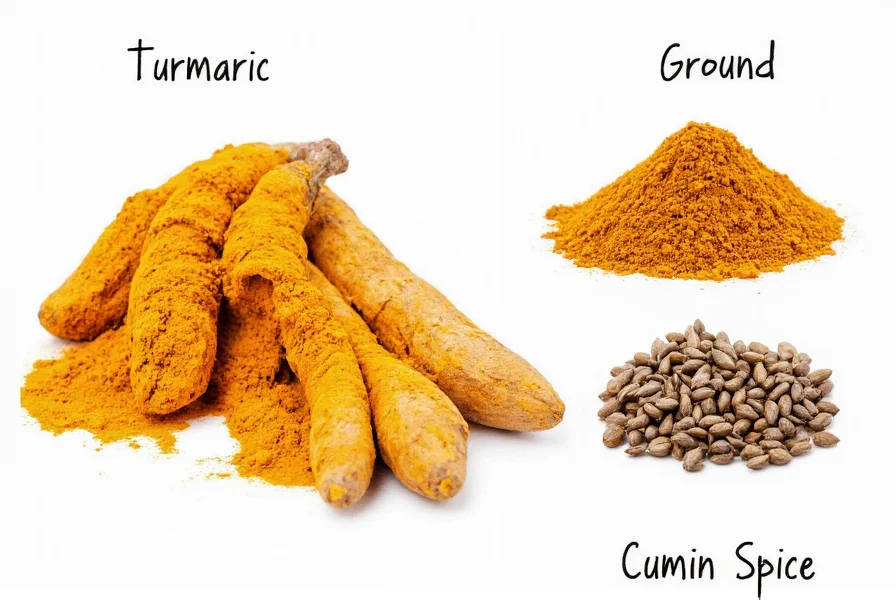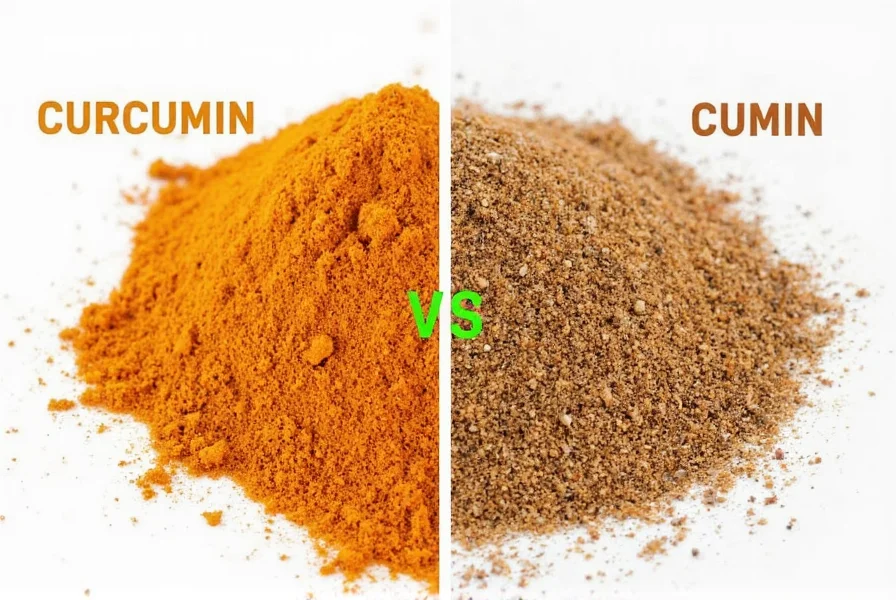Many people confuse curcumin with cumin due to their similar-sounding names, but understanding the difference between curcumin and cumin is essential for both culinary applications and health considerations. This confusion often leads to misunderstandings about their respective benefits and uses.
Understanding the Fundamental Differences
Curcumin originates from turmeric root, which has been used for centuries in Ayurvedic medicine and as a coloring agent. Scientific research has focused extensively on curcumin health effects, particularly its potential anti-inflammatory and antioxidant properties. In contrast, cumin is a seed spice commonly used in Middle Eastern, Indian, and Mexican cuisines, valued for its distinctive warm, earthy flavor profile.
When examining curcumin vs cumin, the most critical distinction is their botanical origin. Turmeric (source of curcumin) belongs to the ginger family (Zingiberaceae), while cumin comes from the parsley family (Apiaceae). This botanical difference explains why these substances have entirely different chemical compositions and biological effects.
| Characteristic | Curcumin | Cumin |
|---|---|---|
| Source | Active compound in turmeric root | Seeds of Cuminum cyminum plant |
| Chemical classification | Polyphenol (curcuminoid) | Terpene (essential oils) |
| Primary color | Bright yellow | Brownish-yellow |
| Culinary use | Coloring agent, subtle flavor | Primary flavor component |
| Supplement form | Extracts, often with piperine for absorption | Rarely taken as supplement |
Curcumin: The Turmeric Compound
Curcumin represents only about 2-8% of turmeric by weight, yet it's the most studied component for potential health applications. Research on curcumin supplement benefits has focused on its possible anti-inflammatory effects, with studies investigating its role in managing conditions like arthritis and metabolic syndrome. However, curcumin absorption presents challenges—it has low bioavailability when consumed alone, which is why many supplements combine it with black pepper extract (piperine) to enhance absorption.
When discussing curcumin in turmeric, it's important to note that whole turmeric contains other curcuminoids (demethoxycurcumin and bisdemethoxycurcumin) that may work synergistically with curcumin. This is different from isolated curcumin supplements, which contain only the single compound.
Cumin: The Culinary Spice
Cumin seed benefits primarily relate to digestion and flavor enhancement rather than the extensive health research associated with curcumin. This spice contains compounds like cuminaldehyde that give it distinctive aromatic properties. In traditional medicine systems, cumin has been used to support digestion and as a carminative, though scientific evidence for these uses is more limited compared to research on curcumin.
The culinary uses of cumin extend across global cuisines—from Indian curries and Mexican chili to Middle Eastern falafel and North African tagines. Unlike curcumin, which is rarely used directly in cooking (as it's extracted from turmeric), cumin is typically used as whole seeds or ground powder to impart its characteristic flavor.
Common Misconceptions Explained
The confusion between curcumin and cumin stems primarily from their phonetic similarity, despite having entirely different etymological origins. Curcumin derives from Curcuma (the genus name for turmeric), while cumin comes from the Arabic каммūн. This linguistic coincidence has led to frequent mix-ups, particularly in health and wellness discussions.
Another common misconception is that consuming turmeric provides the same benefits as taking curcumin supplements. While turmeric contains curcumin, the concentration is relatively low (approximately 3% by weight), and the body absorbs it poorly without enhancement. This explains why curcumin supplements often contain absorption boosters—a consideration not relevant to cumin spice uses.
Practical Applications and Recommendations
For culinary purposes, understanding the difference between curcumin and cumin helps create authentic dishes. Cumin provides distinctive flavor, while turmeric (containing curcumin) primarily contributes color and subtle earthiness. When following recipes, substituting one for the other will significantly alter the dish's flavor profile.
Regarding health applications, those interested in curcumin health effects should look for standardized curcumin extracts, preferably with enhanced absorption technology. For digestive support through culinary means, cumin seed benefits can be accessed through regular cooking with this spice. It's important to note that neither should replace medical treatment, and consulting healthcare providers before using supplements is advisable.

Conclusion
Understanding the distinction between curcumin vs cumin is crucial for making informed decisions in both cooking and health contexts. Curcumin is a specific compound with potential health applications, while cumin is a culinary spice with its own flavor profile and traditional uses. Recognizing these differences helps avoid confusion and ensures proper usage based on intended outcomes—whether for enhancing food flavor or exploring potential health benefits.
Frequently Asked Questions
Is curcumin the same as cumin?
No, curcumin and cumin are completely different substances. Curcumin is a compound found in turmeric, while cumin is a separate spice from a different plant. Despite similar names, they have different chemical structures, sources, and uses.
Can I get enough curcumin from turmeric in my cooking?
Turmeric contains only about 2-8% curcumin by weight, and the body absorbs it poorly without enhancement. While cooking with turmeric provides some curcumin, the amounts are significantly lower than what's found in standardized supplements designed for therapeutic purposes.
What are the main health benefits of curcumin compared to cumin?
Curcumin has been extensively studied for potential anti-inflammatory and antioxidant effects, with research focusing on conditions like arthritis and metabolic health. Cumin's primary benefits relate to digestion and flavor, with more limited scientific evidence for specific health applications compared to curcumin.
Why do curcumin supplements often include black pepper?
Curcumin has low bioavailability, meaning the body doesn't absorb it well. Piperine, a compound in black pepper, can increase curcumin absorption by up to 2000%. This is why many high-quality curcumin supplements include piperine to enhance effectiveness.
Can I substitute cumin for turmeric in recipes?
While both are used in cooking, they have very different flavor profiles and visual effects. Cumin has a strong, earthy flavor, while turmeric provides color with a more subtle taste. Substituting one for the other will significantly change the dish's flavor and appearance, so it's generally not recommended unless making specific adjustments to the recipe.











 浙公网安备
33010002000092号
浙公网安备
33010002000092号 浙B2-20120091-4
浙B2-20120091-4